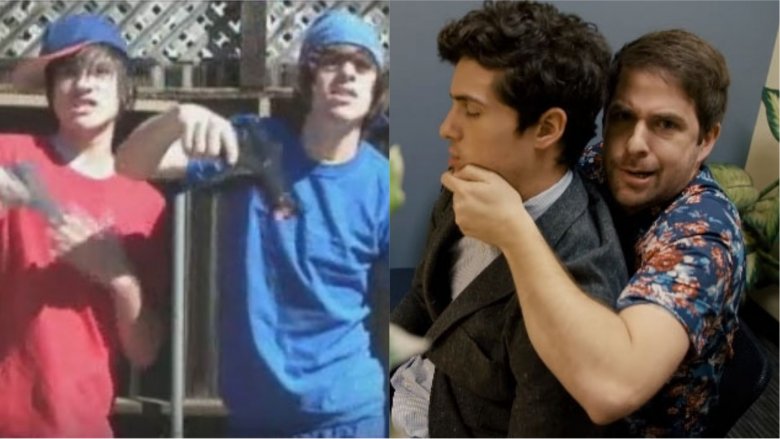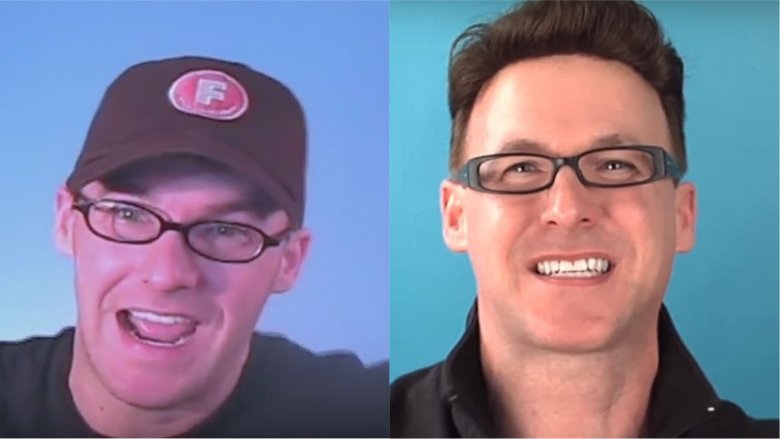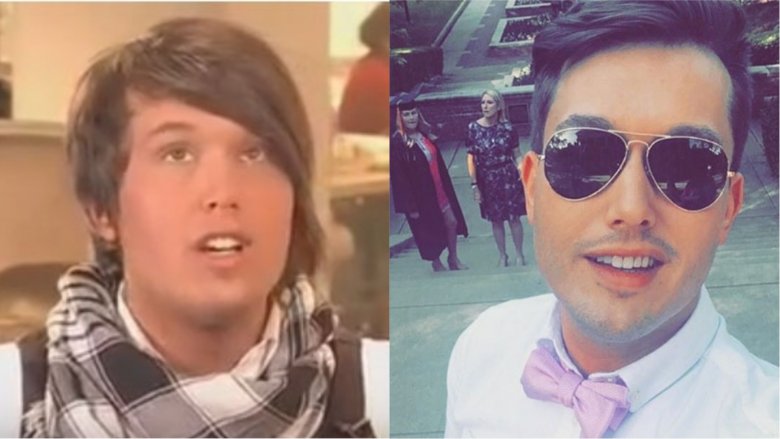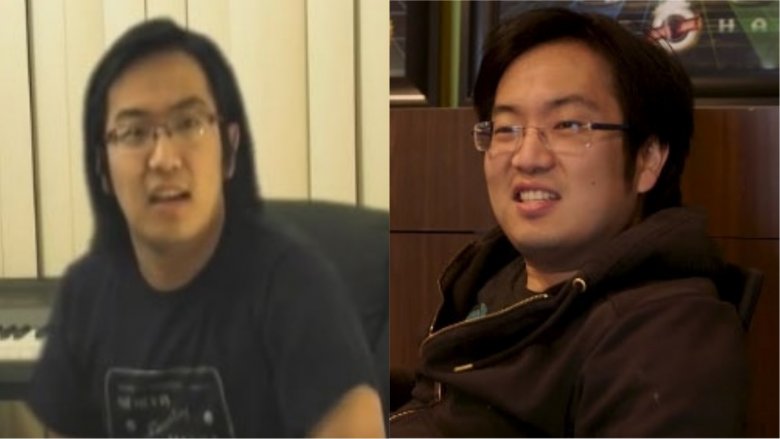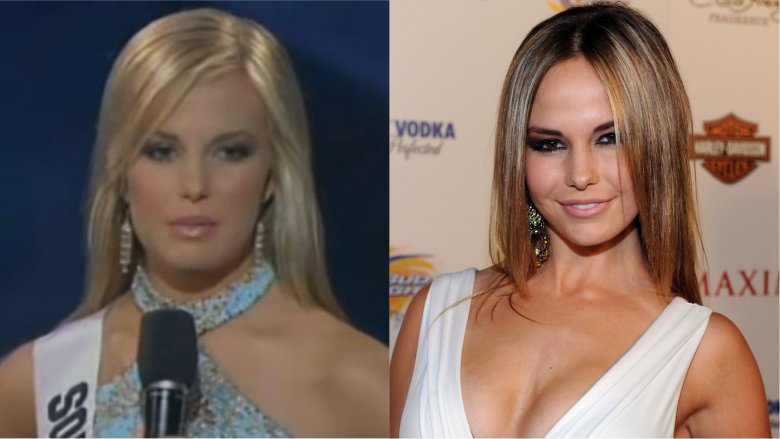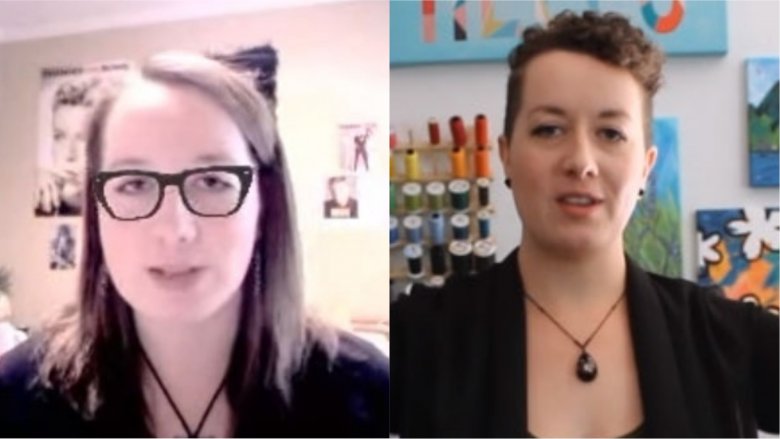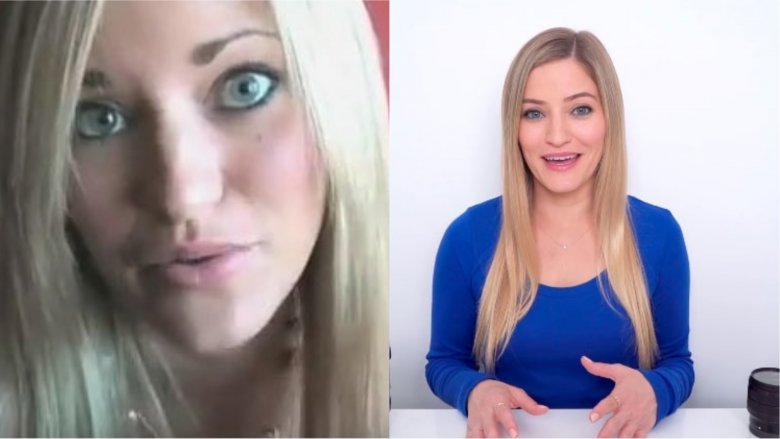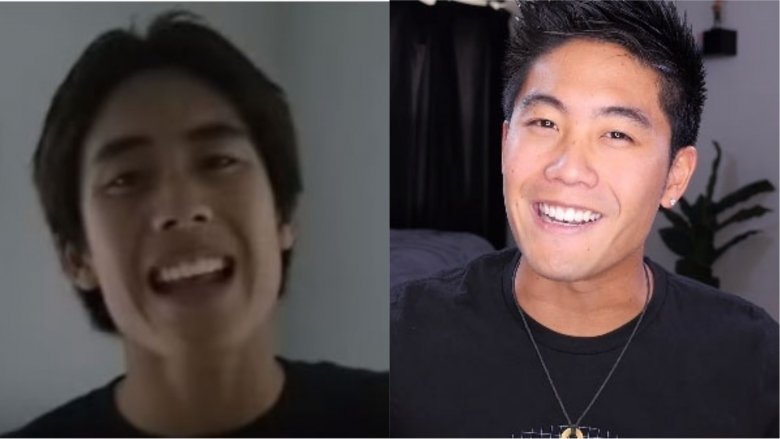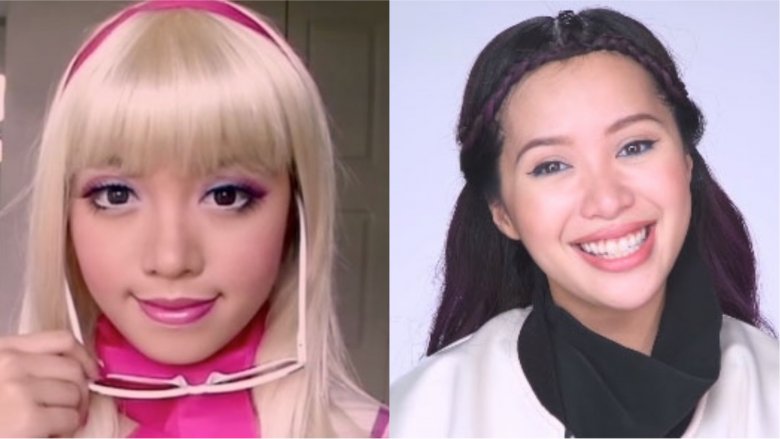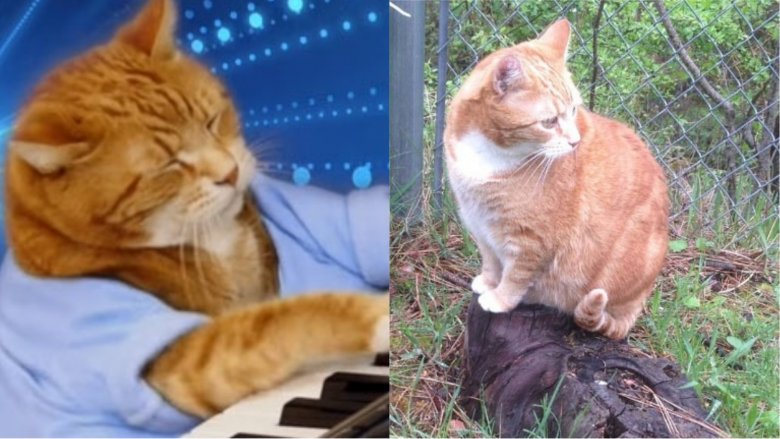Whatever Happened To The First Big YouTube Stars?
We may receive a commission on purchases made from links.
YouTube opened its doors in 2005 and made way for a new kind of celebrity: the viral star. In the days of dial-up, it certainly wasn't easy, but these creators managed to carve out a piece of the internet that was all their own — whether they intended to or not.
Though some viral stars tried to skirt the spotlight after embarrassing flubs (sorry, Miss Teen USA,) those who worked hard ended up having rich careers. Keyboard Cat pioneered the internet's feline obsession and Freddie Wong became a literal Guitar Hero. Today's top YouTubers can command more than $300,000 for a video partnership, but everyone had to start somewhere, and more often than not, it was a teenage bedroom (or an unfortunate day in the student newsroom that they'll never live down.)
So, what happened to the YouTube's very first stars? After navigating the murky waters of brand partnerships, book deals, public embarrassment, and struggles with mental illness, it turns out that most of them are still in the YouTube game.
Anthony Padilla and Ian Hecox (Smosh)
Anthony Padilla launched Smosh.com in 2002 as a place for him and his friends to hangout together after school. A few years later, with best friend Ian Hecox on board, he launched the budding brand's YouTube channel and uploaded a video of himself dancing to the Power Rangers theme song. It was exactly the type of video that characterized early YouTube — silly, lighthearted and lacking HD sheen. The pair quickly became two of YouTube's early stars.
Since then, Smosh's channels have amassed more than 40 million subscribers, 11 billion views, and a dedicated Wikia fan page (which arguably serves as the barometer of viral fame.) They even ventured into feature films with 2015's Smosh: The Movie, a Lionsgate comedy starring Hecox, Padilla, and Michael Ian Black. The flick was widely panned, with reviewers claiming it was "a lowbrow comic adventure" and "one of the worst forms of media I've ever laid my eyes upon." That didn't stop this crew, but it was the beginning of the end for Padilla.
Amidst creative pressures from Defy Media, who purchased Smosh, Padilla reportedly ended his 12-year partnership with Hecox to focus on his own endeavors. "I had to come to terms with the fact that Smosh being part of a company has put all of my creative decisions through a filter of what's appropriate for the Smosh brand as deemed by the company. I need to feel that happiness again," he said in a teary-eyed vlog (via Vulture).
Michael Buckley (What The Buck?)
In the summer of 2006, Michael Buckley took to YouTube to launch his public access style show What the Buck? He got his humble start posting on his cousin's channel, then rose to viral fame on his own after releasing a reaction to the NSFW viral hit "Two Girls One Cup." At one point, Buckley had four of the top ten most-viewed videos on YouTube. So, where is he more than a decade later?
Still killing it. Buckley's first viral video has amassed more than 11 million views. His original channel was suspended in 2007, but he managed to successfully jump ship to BuckHollywood, which has nearly a million followers, and to Michael Buckley, which has around 25,000 subscribers.
"You start making money, and you think you've tricked the world," Buckley told Ars Technica, describing his viral fame. "How did this happen? I was doing this for fun, and for free, and now I have thousands of dollars in my Adsense account. This is crazy. It's nutty."
This online personality has kept busy in Hollywood, hosting red carpet interviews at both the 2011 American Music Awards and 2010 Teen Choice Awards. He became one of the first YouTube stars on network TV after winning a chance to co-host Live! With Kelly during "Live's Coast-to-Coast Co-Host Search." Buckley also authored a book about becoming a YouTube star and has even offered courses for aspiring YouTubers.
William Sledd ('Ask a Gay Man')
William Sledd was a humble Gap manager before he launched his eponymous channel in 2006, featuring his wildly popular series, "Ask A Gay Man." In the series, Sledd would snarkily sound off on fashion trends — from toe rings and mom jeans to man bags. By 2007, the YouTube celeb was getting mainstream media attention. He was name-checked on The View, inked a deal with NBC for a Bravo webseries, and regularly interviewed some of fashion's most renowned designers.
Despite Sledd's massive YouTube success and the hopeful jump to a mainstream TV network, things never really panned out. Bravo ultimately cut funding for OutZoneTv.com, which was hosting Sledd's Ask a Gay Man series. According to Gigaom, "Bravo ultimately decided it couldn't justify the time spent finding advertising for such a niche property." Sledd got out of the YouTube game and became a social media consultant for a local Kentucky bank. He posted his last video in 2013.
"I'm not a spring chicken anymore," he told CNet in 2009. "I'm going to be 26 this year, so I'm like 'How long am I going to be sitting around the house making YouTube videos from the bedroom?'"
Sledd now spends his days hanging out with his adorable French bulldog and cheering on Hillary Clinton.
Fritz Grobe and Stephen Volts (EepyBird)
Have you ever put a tube of Mentos in a 2-liter bottle of Diet Coke to see what happens? You can thank Fritz Grobe and Stephen Volts for the viral science experiment that annoyed a generation of parents and left a giant mess in backyards, driveways, and living rooms around the world. Grobe and Voltz, better known as the Coke and Mentos guys, launched EepyBird's YouTube channel in 2006 and quickly rose to fame with their "Extreme Mentos & Diet Coke" experiments. Shortly after, the duo found themselves touring around the world and appearing with their experiments on programs such as The Late Show with David Letterman, Ellen, and The Today Show. They even appeared in the video for Weezer's Grammy Award-winning song "Pork and Beans" and scored two Emmy nominations and four Webby Awards.
Today, Grobe and Volts are still doing Eepybird, but they've found success beyond YouTube. After becoming one of the first YouTube channels to land an influencer marketing campaign and partnering up with brands such as Coca-Cola, ABC Family, and Google, the pair launched its own social-media consulting firm. Grobe and Volts regularly speak at colleges and conventions around the world (landing a coveted TED Talk was no exception). The duo also authored two books: The Viral Video Manifesto, which helps teach marketers and YouTube hobbyists how to court viral success, and How to Build a Hovercraft, which outlines more than 25 DIY science experiments.
Brian Collins (Boom Goes the Dynamite)
In 2005, Brian Collins was a Ball State University freshman majoring in telecommunications and volunteering on the student-run newscast Newslink@9. After the regular anchor called in sick, the Ohio-native stepped up to do the sports segment — but he had no idea what he was in for. Collins fumbled through the entire newscast, partly because of an inexperienced tech running the teleprompter and partly because he grew increasingly more nervous with every mistake. His efforts probably would have been completely forgotten (like most of the world's early-career mishaps) had Collins not coined the sports catchphrase to end all catchphrases: "Boom goes the dynamite."
Collins didn't have his own YouTube channel, but he quickly became internet-famous after savvy online guru Jeremy Goldman uploaded the painfully awkward clip. Collins soon found himself doling out interviews for the likes of ESPN and The Late Show with David Letterman. SportsCenter news anchor Scott Van Pelt even paid homage to the unexpected star by using his catchphrase on air.
As it turns out, Collins did eventually become a TV reporter for KXXV-TV after graduating from college, but he was reportedly laid off a year later during budget cuts. He briefly moved on to WXIX-TV, where he was a freelance web producer, and KSAX, where he was a multimedia journalist, before landing on Premier Content Source. At this point, Collins has been working at Premier Content Source for most of his professional career, proving that you truly can find success after the dynamite goes boom.
Freddie Wong (RocketJump)
YouTube today is a totally different climate from the crudely cut comedy videos of the early aughts. Gamers have become a staple, largely pioneered by 2007 World Series of Videos Games winner Freddie Wong. That's not to say Wong wasn't a fan of DIY comedy. The Internet celebrity got his start in 2006 by posting comedic action films on his RocketJump channel, but his gaming videos are what crafted a legacy.
Wong's Guitar Hero rendition of Rush's "YYZ" garnered more than 8 million views between 2006 and 2011, when the YouTuber was swiftly becoming one of the most famous gamers on the platform. Since then, Wong has amassed more than 8 million followers largely due to his popular series Video Game High School. In recent years, the YouTuber raised nearly $900,000 on IndieGoGo for the last season of the series. He also launched a gaming channel called NODE with fellow YouTube stars that amassed more than 2.5 million subscribers, and Wong has made TV appearances on Key & Peele, Chuck, and Rob Dyrdek's Fantasy Factory. In 2015, he partnered with Lionsgate for his own Hulu series called RocketJump: The Show and for the sci-fi anthology show Dimension 404.
Caitlin Upton
Miss Teen USA didn't have a YouTube channel of her own, but she achieved massive notoriety online after a video of her absent-minded answer to a pageant question amassed millions of views — as in more than 67 million views. In the footage, Caitlin Upton answers a rather tricky question from actress Aimee Teegarden about why she thinks a fifth of Americans can't locate the United States on a map. There's no pageant queen-approved answer for calling your nation willfully ignorant, so Upton rambled on for 35 seconds claiming people "don't have maps" and "I believe that our education like such as in South Africa and, uh, the Iraq, everywhere like such as, and, I believe that they should, our education over here in the U.S. should help the U.S." What?
Upton told New York Magazine that she became suicidal after the incident because of all the negative backlash she received, which included bizarre threats about her body being eaten alive by ants or burned in a fire. Still, she managed to use her moment in the spotlight to catapult her career. She has since hosted web shows for The Travel Channel and Travelocity and appearing on Law and Order and Boston Legal. Against all odds, she clawed her way through Season 16 of The Amazing Race and placed third — so she's apparently pretty good at navigating, with or without a map.
Today, Upton is more likely to be answering questions about square footage because she's reportedly working as a real estate agent.
Melody Oliveria (bowiechick)
Melody Oliveria socred a viral hit with her channel bowiechick after posting a candid video documenting her breakup with her boyfriend. Throughout the video, Oliveria shifted through filters on her webcam — from scuba masks to gas masks. Though breakups are tough, her chipper but sarcastic attitude told us she was going to be a-okay — and we were right.
Today, Oliveria only posts on YouTube occasionally, but that's because she spends most of her time working at a non-profit. Though her outlook is rosy (and she's finally found love with another woman,) this YouTuber fell into a deep depression in 2016. At the advice of her subscribers, she eventually saw a therapist, started taking medication and making positive changes in her life.
"I was legit in a dark place and I had decided that I would only give myself one year to get happy, and that was kind of more of a threat than a challenge," she said. "...June of this year, I was already so happy and in such an amazing place that I didn't even consider these thoughts that I had thought before."
Justine Ezarik (iJustine)
Justine Ezarik started vlogging in 2006, but first rose to YouTube fame a year later after a video of herself reading through her 300-page phone bill went viral — totally relatable! Things got even more real when she spent six month livestreaming her life 24/7 for Justin.TV, an experience that she said made her "anxious and paranoid." Despite the ill-advised livestream, iJustine is still dominating YouTube a decade later, only now she has more than 4.7 million followers.
Ezarik has stuck with her brutally honest and cheekily self-aware brand — from filming impromptu dances on airplanes to sharing her biggest secrets. In 2016, she even partnered with The Daily Dot for a video where she watched and reacted to her oldest YouTube gems. It doesn't get more self-aware than that.
Ezarik's success isn't strictly limited to YouTube. In 2015, she penned a memoir called iJustine, an Analog Memoir, and two years later, she lent her voice to the animated film A Stork's Journey. Despite her long list of successes, she says the accomplishment she's most proud of is adopting her dog. "I've never really had a dog on my own before, so getting one has been pretty exciting. He's my baby," she told Sweety High.
Ryan Higa (NigaHiga)
Like most of YouTube's earliest stars, Ryan Higa launched his channel NigaHiga in 2006. The name plays off of the Japanese word for "rant" and his first video, "How to be a Ninja," riffed off of Asian stereotypes while racking up 50 million views. Since then, Higa's channels, including both NigaHiga and HigaTV, have more than 24 million subscribers and 4 billion views. So how did he maintain his success for more than a decade?
Higa, who's estimated annual ad earnings clocked in at just over $600,000 in 2015, credits his success to good old-fashioned hard work. He told Etc. there's "not one day where I'm not at least writing something, unless it's on a [day with a scheduled appearance]. Literally, whatever I'm doing, even if I go out at night -– I spend most of my time writing and creating." That work ethic landed him a lucrative partnership with Lenovo in 2015, the same year Variety crowned him the No. 1 digital star.
In fact, it feels like Higa can't fail even if he tries. When he created a K-Pop group with his friends as a joke in 2017, the album swiftly rose to the No. 1 spot on the K-Pop charts. The band, BGA or "Boys Generally Asian," was praised among fans and managed to momentarily beat out BTS, one of the best-selling K-Pop bands in recent history.
Michelle Phan
Today's beauty community on YouTube is thriving thanks, in no small part, to Michelle Phan, one of the original YouTube beauty gurus. Phan began posting easy-to-follow makeup tutorials in 2006 and cultivated a massive following (today she has more than 8.9 million subscribers.) By 2009, she was a full-blown internet celebrity, and her famous Barbie-inspired makeup tutorial has amassed more than 63 million views!
More than a decade after Phan launched her channel, she's still a massive online celebrity. The only difference is that she's got a couple lucrative brand partnerships under her belt and has become a multi-millionaire. In 2010, she partnered with Lancome to become the first YouTuber hired as a brand's official video makeup artist. Three years later, she landed a deal with L'Oreal for her own line of cosmetics called Em Michelle Phan, which was later sold to Ipsy, a makeup sampling startup founded by Phan that's worth an estimated $500 million.
In 2016, Phan landed on the cover of Forbes and Nylon, but not everything was peachy-keen for the YouTube mogul. She was struggling with depression, which ultimately caused her to quit YouTube. "You would think, This achievement is great. You should be happy. But I wasn't. I was waking up feeling so broken. I didn't know why," she told Racked.
Bento Schmidt (Keyboard Cat)
Videos of silly cats are a dime a dozen today. Sure, they're always appreciated (who doesn't love a good cat fail or an adorable meme,) but the novelty has worn off. In the dredges of YouTube, which has more pet videos than the human race can feasibley watch in a lifetime, one cat still stands out in the crowd. His legacy has left hundreds of parodies and a few angry house cats who were forced to wear ridiculous outfits in his wake.
Before Grumpy Cat, Lil Bub, and viral Pop Tart-slash-Kitty Nyan Cat, there was the one and only Keyboard Cat. This fluffy feline paved the way for his species' massive YouTube success, and it all started from a 2009 video posted by owner Charlie Schmidt and tweeted by Ashton Kutcher. Fame was instantaneous, and the original clip has since amassed more than 50 million views.
Alas, the beloved cat known as Bento to his inncer circle, passed away in 2018. The tragic news rocked Keyboard Cat's more than 800,000 Facebook fans, and the pretty kitty even received a special tribute from TV host Jimmy Kimmel. Keyboard Cat was just 9 years old.

